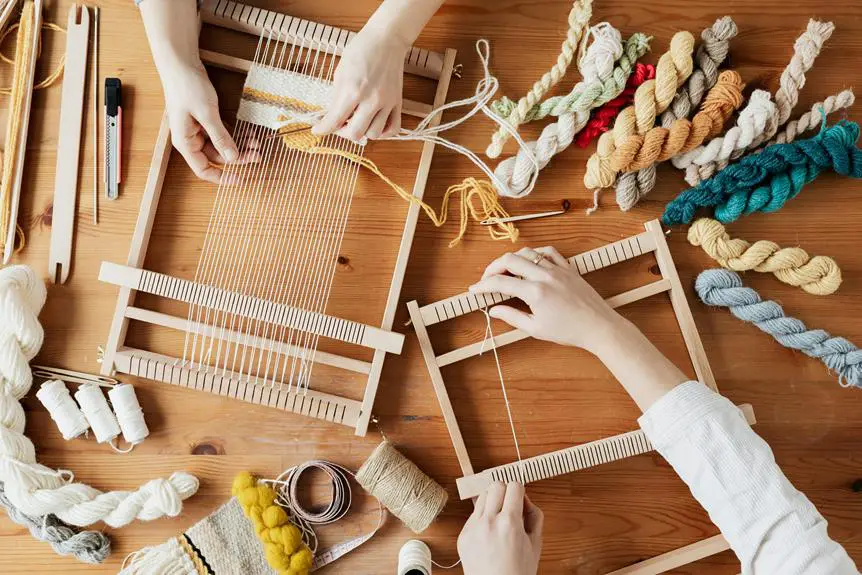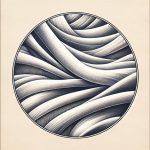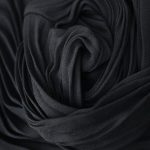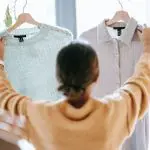When you think about poplin fabric, it's easy to overlook the intricate weaving process that brings it to life. Starting with high-quality fibers, the fabric is created using a plain weave technique where warp and weft threads intersect in a precise manner. This technique not only enhances the fabric's durability but also contributes to its smooth texture. You might wonder how different types of fibers and machinery impact this process, and what effects they have on the final product. Let's explore that further.
Table of Contents
Key Takeaways
- Poplin fabric begins with selecting high-quality cotton or cotton blends for its softness and durability.
- The weaving process employs a plain weave technique, intertwining warp and weft threads for a smooth finish.
- Warp threads run vertically, providing strength, while weft threads run horizontally, creating the fabric structure.
- The tightly woven threads result in a lightweight yet strong fabric, ideal for various applications.
Understanding Poplin Fabric
Poplin fabric is a versatile, tightly woven textile that's known for its smooth finish and durability. You might recognize it from its use in shirts, dresses, and even home furnishings. The fabric's tight weave gives it a crisp feel, making it an excellent choice for both formal and casual attire.
One of the standout features of poplin is its ability to drape well, which adds elegance to your garments. You'll find it comfortable against the skin, thanks to its breathable nature. Whether you're wearing a tailored shirt or a flowing dress, poplin adapts to different styles seamlessly.
Additionally, poplin comes in various weights and colors, allowing you to choose the right option for your specific needs. If you're looking for something lightweight for summer wear or a heavier variant for cooler months, poplin has you covered.
Its durability means that garments made from this fabric can withstand frequent wear and washing, retaining their shape and color over time.
In short, poplin fabric is an excellent investment for anyone looking to enhance their wardrobe with high-quality, stylish options.
The Weaving Process Explained
Understanding how poplin fabric is woven helps explain its distinctive qualities and durability, making it a popular choice in fashion and home textiles.
The weaving process begins with selecting high-quality cotton or a cotton blend. You'll find that poplin is typically woven using a plain weave technique, which is straightforward yet effective in creating a smooth, tight fabric.
During the weaving process, the warp threads are set up on a loom, running vertically. You'll then see the weft threads, which run horizontally, interlaced through the warp. This simple over-and-under pattern forms the basis of poplin's structure. Because the threads are tightly woven together, the resulting fabric becomes lightweight yet strong.
As the loom operates, you'll notice the fabric gradually taking shape, showcasing its characteristic sheen and softness. The process can be automated, increasing efficiency and consistency in the final product.
Once woven, the fabric is typically finished with treatments that enhance its feel and appearance, making it ready for dyeing or printing. By understanding this weaving process, you appreciate the craftsmanship behind poplin and its versatile applications in clothing and home décor.
Warp and Weft Basics
In fabric construction, the terms 'warp' and 'weft' refer to the two fundamental sets of threads that create the textile structure.
The warp threads run lengthwise on the loom, providing the fabric's strength and stability. You can think of them as the backbone of the fabric. They're typically tightly stretched and remain fixed during the weaving process.
On the other hand, the weft threads run crosswise, interlacing with the warp threads to form the fabric. As you weave, you'll pass the weft over and under the warp, creating patterns and texture. This interlacing is what gives the poplin its distinctive look and feel.
The balance between warp and weft is crucial. If the warp is too tight, the fabric may become stiff; if it's too loose, you risk losing durability. Likewise, the weft needs to be woven at the right tension to maintain the fabric's integrity.
Understanding these basics helps you appreciate the complexity involved in creating poplin fabric and other textiles. It's this interplay between warp and weft that ultimately determines the fabric's characteristics, like its drape and durability.
Types of Fibers Used
Various fibers can be used to create poplin fabric, each offering unique qualities and characteristics. The most common fibers include cotton, polyester, and silk.
Cotton poplin is soft, breathable, and perfect for everyday clothing. It's an excellent choice if you want comfort and ease of care, as it's machine washable and durable.
On the other hand, polyester poplin is wrinkle-resistant and often more affordable. It's a great option for uniforms or items that need to maintain a crisp appearance without much upkeep.
If you're looking for something luxurious, silk poplin is your best bet. It has a beautiful sheen and feels incredibly soft against the skin, making it ideal for high-end garments.
You might also encounter blends, such as cotton-polyester poplin, which combine the best features of both fibers. These blends are often stronger and more versatile, catering to various applications from fashion to home decor.
When choosing a poplin fabric, consider the fiber content to ensure it meets your specific needs and preferences. Each fiber type brings something special to the table, allowing you to find the perfect fit for your project.
Machinery in Fabric Production
The production of poplin fabric relies on specialized machinery that processes the chosen fibers into the final textile. These machines are essential for transforming raw materials into the smooth, durable fabric you've come to appreciate.
You'll find that different types of machinery play key roles in this process, ensuring efficiency and quality.
Here are some crucial machines involved in poplin fabric production:
- Spinning Machines: They twist and spin fibers into yarn, crucial for achieving the desired texture and strength.
- Weaving Looms: These machines interlace the yarns to create the poplin weave, where the over-and-under pattern gives the fabric its characteristic finish.
- Finishing Equipment: After weaving, this machinery treats the fabric to enhance its properties, such as softness and durability.
Frequently Asked Questions
What Are the Main Uses of Poplin Fabric?
Poplin fabric's soft texture and durability make it perfect for shirts, dresses, and home textiles. You'll love its versatility, whether you're dressing up for an event or lounging comfortably at home. It's a wardrobe essential!
How Does Poplin Compare to Other Fabrics?
When you compare poplin to other fabrics, you'll notice it's lightweight, smooth, and durable. Unlike heavier fabrics, it breathes well, making it ideal for warm weather, while still offering versatility for various clothing styles.
Is Poplin Fabric Easy to Care For?
Yes, poplin fabric's easy to care for! It's machine washable, resists wrinkles, and dries quickly. You won't need to worry much about special treatment, making it a practical choice for everyday wear.
Can Poplin Be Dyed or Printed Easily?
Yes, you can dye or print poplin easily. Its smooth surface and tight weave absorb colors well, making it a great choice for vibrant designs. Just be sure to follow proper dyeing techniques for best results!
What Is the History of Poplin Fabric?
Poplin fabric has a rich history dating back to the 15th century. Originally made from silk, it evolved into cotton blends, making it popular in clothing and home textiles. You'll appreciate its versatility and timeless appeal.
- Why Open-Weave Scrim Is the Secret to Stunning Event and Canopy Designs - June 26, 2025
- Creating Large-Scale Art Installations With Scrim Fabric - June 26, 2025
- Scrim Fabric in Upholstery: Understanding Its Use as a Backing Material - June 26, 2025







